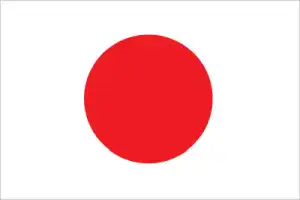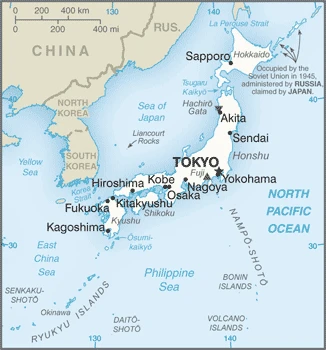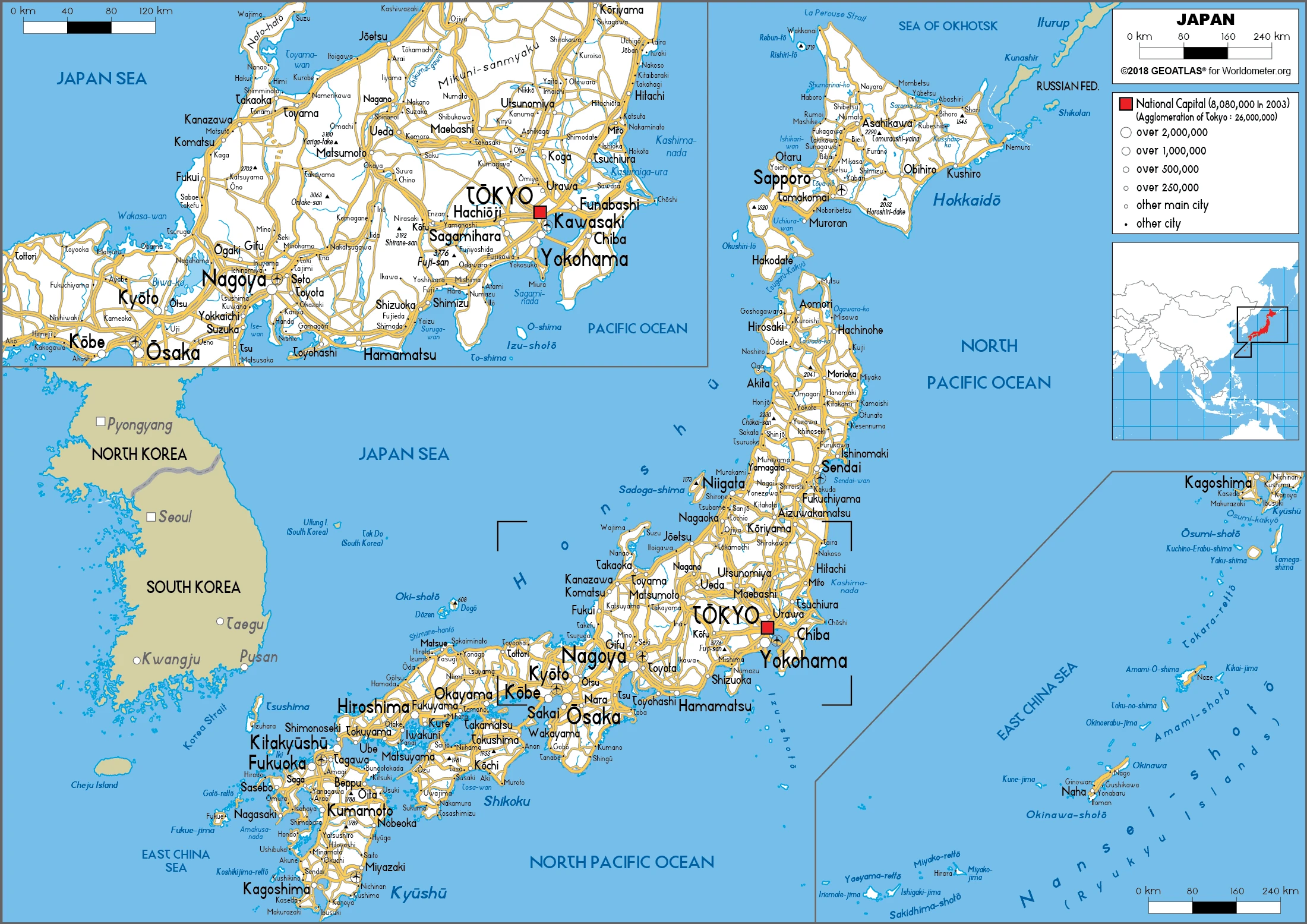Japan Google Maps is a site/tool that offers a wide range of map views (topographic, satellite, street view) and navigation options, with little effort on your part, yet efficiently. If you need to plan a trip to a new place like Japan, Google maps are available on desktop, mobile, or tablet. This Google maps and information page is dedicated to Japan, Asia (22 countries), showing its location, country facts, details about its capital city Tokyo, and plenty of other information which may be interesting when you visit this Asian state.
Quick links: Google Maps Japan, Tokyo Google maps, Driving Directions Japan, Printable Road Map.

About Japan in a nutshell
- Conventional short form of the name: Japan
- The conventional long form of the name: none
- Local long form: Nihon-koku / Nippon-koku
- Local short form: Nihon / Nippon
- Etymology: the English word for Japan comes via the Chinese name for the country Cipangu; both Nihon and Nippon mean where the sun originates and are frequently translated as Land of the Rising Sun.
- The legal system in Japan: civil law system based on German model; system also reflects Anglo-American influence and Japanese traditions; judicial review of legislative acts in the Supreme Court.
- Climate: Generally temperateoceanic. Spring is warm and sunny, while summer is hot and humid, with high rainfall. In western Hokkaido and northwest Honshu, winters are freezing, with heavy snowfall. Freak storms and damaging floods in recent years have raised concern over global changes.
Japan has not been spIn recent years, freak by nature, with four, signify around a thousand smaller ones spanning 20 degrees latitude. It has few energy and mineral resources; its surface is primarily mountainous, with hardly any lowlands or arable land. The island nation’s location means that the summer and winter monsoons bring rain, but its rivers are short and have little fall. Nor are the sea currents much help: a cold current cools in the north, and a warm current warms the coast in the south, which is hot anyway. So the labor force, based on a population of 128 million, remains a hope: advanced technology requires a high degree of precision. The country, perhaps the most expensive destination globally, is best visited by rail: trains are fast, frequent, and, like the Shinkansen super-express, often considered the symbol of modern Japan, comfortable and punctual. A tour of Japan’s World Heritage Sites, pagodas, and religious monuments in the former capitals of Nara and Kyoto, shogunate fortresses, national parks with unique vegetation in the northern regions, and the ruined cities of the Ryukyu Islands, will give you a different picture of Japan.
The Japanese are still among the worlds most avid newspaper readers, with around 47 million copies daily sales.
Background
In 1603, after decades of civil warfare, the Tokugawa shogunate (a military-led, dynastic government) ushered in a long period of relative political stability and isolation from foreign influence. For more than two centuries, this policy enabled Japan to enjoy a flowering of its indigenous culture. Japan opened its ports after signing the Treaty of Kanagawa with the U.S. in 1854 and began to modernize and industrialize intensively. During the late 19th and early 20th centuries, Japan became a regional power that could defeat the forces of both China and Russia. It occupied Korea, Formosa (Taiwan), and southern Sakhalin Island. In 1931-32 Japan occupied Manchuria, and in 1937 it launched a full-scale invasion of China. Japan attacked U.S. forces in 1941 – triggering America’s entry into World War II – and soon occupied much of East and Southeast Asia. After its defeat in World War II, Japan recovered to become an economic power and an ally of the U.S.
While the emperor retains his throne as a symbol of national unity, elected politicians hold actual decision-making power. Following three decades of unprecedented growth, Japan’s economy experienced a significant slowdown starting in the 1990s, but the country remains an economic power. In March 2011, Japan’s strongest-ever earthquake, and an accompanying tsunami, devastated the northeast part of Honshu island, killed thousands, and damaged several nuclear power plants. Prime Minister Shinzo Abe was re-elected to office in December 2012 and has since embarked on ambitious economic and security reforms to improve Japan’s economy and bolster the country’s international standing. In November 2019, ABE became Japan’s longest-serving post-war prime minister.
Geography
The terrain is predominantly mountainous, with fertile coastal plains; over two-thirds is woodland. There is no single continuous mountain range; the mountains divide into small land blocks separated by lowlands and dissected by numerous river valleys. The islands lie on the Pacific “Ring of Fire,” and frequent earthquakes and volcanic eruptions. The Pacific coast is vulnerable to tsunamis. There are numerous hot springs.

Japan is located off the east Asian coast and comprises four principal islands and over 3000 smaller ones. A robust economy has an emperor as ceremonial head of state.
This state is located in Eastern Asia, an island chain between the North Pacific Ocean and the Sea of Japan, east of the Korean Peninsula, under the coordinates of 36 00 N, 138 00 E, covering an area of 377,915 sq km with a coastline of 29,751 km. Japan is slightly smaller than California.
Mostly rugged and mountainous, with Mount fuji at 3,776 m as the highest point of Japan, while Hachiro-gata -4 m as the lowest point, causing a mean elevation of 438 m throughout the country. With a total of 377,915 sq km, Japan has 364,485 sq km of land and 13,430 sq km of water surface area.
Major water bodies in the country: Biwa-ko 688 sq km (a freshwater lake).
Strategic location in northeast Asia comprises four main islands – from the north: Hokkaido, Honshu (the largest and most populous), Shikoku, and Kyushu (the Home Islands) – and 6,848 smaller islands and islets.
The climate in Japan is as follows: It varies from tropical in the south to cool temperate in the north.
When you visit Japan, the natural hazards shall be considered: Many dormant and some active volcanoes; about 1,500 seismic occurrences (primarily tremors but occasional severe earthquakes) every year; tsunamis; typhoons volcanism: both Unzen (1,500 m) and Sakura-Jima (1,117 m), which lies near the densely populated city of Kagoshima, have been deemed decade volcanoes by the international association of volcanology and chemistry of the interior of the earth, worthy of study due to their tumultuous history and proximity to human populations; other notable historically active volcanoes include Asama, Honshu islands most active volcano, Aso, Bandai, Fuji, Iwo-Jima, Kikai, Kirishima, Komaga-Take, Oshima, Suwanosejima, Tokachi, Yake-Dake, and Usu.
The following major health-threatening issues shall be considered when visiting Japan: none.
Current environmental issues affecting the Japanese people: air pollution from power plant emissions results in acid rain; acidification of lakes and reservoirs degrading water quality and threatening aquatic life; Japan is one of the largest consumers of fish and tropical timber, contributing to the depletion of these resources in Asia and elsewhere; following the 2011 Fukushima nuclear disaster, Japan originally planned to phase out nuclear power, but it has now implemented a new policy of seeking to restart nuclear power plants that meet strict new safety standards; waste management is an ongoing issue; Japanese municipal facilities used to burn high volumes of trash, but air pollution issues forced the government to adopt an aggressive recycling policy.
Google Maps Japan
The capital and other divisions
Capital city: Tokyo found under the coordinates 35 41 N, 139 45 E, applying the time zone UTC+9 (14 hours ahead of Washington, DC, during Standard Time), using the following daylight saving time: none.
Tokyo is the capital of Japan and one of the most visited cities in the world. With a lot of variety, excellent transportation, and an exciting history, this city has much to offer! A city of complex layers and many faces, Tokyo is the place where you can find anything from cuisine to shopping.
Japan became independent on 3 May 1947 (current constitution adopted as an amendment to Meiji Constitution); notable earlier dates: 11 February 660 B.C. (mythological date of the founding of the nation by Emperor JIMMU); 29 November 1890 (Meiji Constitution provides for constitutional monarchy), and its national holiday is Birthday of Emperor NARUHITO, 23 February (1960).
Administrative divisions: 47 prefectures; Aichi, Akita, Aomori, Chiba, Ehime, Fukui, Fukuoka, Fukushima, Gifu, Gunma, Hiroshima, Hokkaido, Hyogo, Ibaraki, Ishikawa, Iwate, Kagawa, Kagoshima, Kanagawa, Kochi, Kumamoto, Kyoto, Mie, Miyagi, Miyazaki, Nagano, Nagasaki, Nara, Niigata, Oita, Okayama, Okinawa, Osaka, Saga, Saitama, Shiga, Shimane, Shizuoka, Tochigi, Tokushima, Tokyo, Tottori, Toyama, Wakayama, Yamagata, Yamaguchi, Yamanashi.
People and society
One of the most racially homogeneous societies in the world. A sense of order and social structure was founded on strongly ingrained respect for elders and social superiors. This underpinned the now much-diluted “lifetime employer” concept in business, where company allegiance determined social life and career. There is little tradition of generational rebellion, but the youth market is robust and current fashions focus on teenagers. The education system is highly pressurized. Nongraduates have difficulty reaching management-level jobs, so competition for university places is intense. Long-term jobs for women are now the norm. One of the worlds best healthcare systems and increased longevity have led to an aging population, with one in four people already over 65. The cost of living is high, especially in Tokyo.
The population in Japan is 124,687,293 (July 2021 estimate), with an average of -0.37% (2021 estimate) change. That means Japan is the No. 11 in the world’s populated rank list. With an average of 48.6 years median age (47.2 years for males and 47.2 years for women), Japan ranks No. 2 on the globe’s median age rank list.
The people living in this country are the Japanese (also singular and plural) (noun) or Japanese (adjective) and belong mainly to the following ethnic groups: Japanese 97.9%, Chinese 0.6%, Korean 0.4%, other 1.1% (includes Vietnamese, Filipino, and Brazilian) (2017 estimate). Note: data represent population by nationality; up to 230,000 Brazilian Japanese origins migrated to Japan in the 1990s to work in industries; some have returned to Brazil.
They speak Japanese languages and practice the following religions: Shintoism 69%, Buddhism 66.7%, Christianity 1.5%, other 6.2% (2018 estimate). Note: total adherents exceed 100% because many people practice Shintoism and Buddhism.
We can conclude the following about the population in Japan: All primary and secondary regions of high population density lie on the coast. One-third of the population resides in and around Tokyo on the central plain (Kanto plain). In Japan, we talk about 91.9% (2021) of the total population lives in cities. Most of them reside in the following municipalities: 37.340 million, Tokyo (capital city), 19.111 million, Osaka, 9.566 million, Nagoya, 5.516 million, Kitakyushu-Fukuoka, 2.930 million, Shizuoka-Hamamatsu, 2.670 million, Sapporo (2021).
Industry
Worlds third-largest economy. A market leader in high-tech electronics and cars. The global spread of business. Once revolutionary management and production methods. Long-term research and development. Talent for developing ideas from abroad. Protectionism in the domestic economy. Traditional economic power brokers delayed the reform of the financial sector. Major coal importer. Retreat from nuclear power after massive damage caused by 2011 earthquake and tsunami: resulting energy imports bill ended 30 years of trade surpluses.
Over the past 70 years, government-industry cooperation, a strong work ethic, mastery of high technology, and a comparatively small defense allocation (slightly less than 1% of GDP) have helped Japan develop an advanced economy. Two notable characteristics of the post-World War II economy were the close interlocking structures of manufacturers, suppliers, and distributors, known as keiretsu, and the guarantee of lifetime employment for a substantial portion of the urban labor force. Both features have significantly eroded under the dual pressures of global competition and domestic demographic change. Measured on a purchasing power parity basis that adjusts for price differences, Japan in 2017 stood as the fourth-largest economy in the world after first-place China, which surpassed Japan in 2001, and third-place India, which edged out Japan in 2012. For three postwar decades, overall real economic growth was impressive – averaging 10% in the 1960s, 5% in the 1970s, and 4% in the 1980s. Growth slowed markedly in the 1990s, averaging just 1.7%, mainly because of the aftereffects of inefficient investment and the collapse of an asset price bubble in the late 1980s, which resulted in several years of economic stagnation as firms sought to reduce excess debt, capital, and labor. Modest economic growth continued after 2000, but the economy has fallen into recession four times since 2008. Japan enjoyed an uptick in growth since 2013, supported by Prime Minister Shinzo ABE’s Three Arrows economic revitalization agenda – dubbed Abenomics – of monetary easing, flexible fiscal policy, and structural reform. Led by the Bank of Japan’s aggressive monetary easing, Japan is making modest progress in ending deflation. Still, demographic decline, a low birth rate, and an aging, shrinking population pose a major long-term challenge for the economy.
The government currently faces the difficulty of balancing its efforts to stimulate growth and institute economic reforms with the need to address its sizable public debt, which stands at 235% of GDP. To help raise government revenue, Japan adopted legislation in 2012 to gradually raise the consumption tax rate. However, the first such increase, in April 2014, led to a sharp contraction, so Prime Minister ABE has twice postponed the subsequent increase, which is now scheduled for October 2019. Structural reforms to unlock productivity are seen as central to strengthening the economy in the long run. Scarce in critical natural resources, Japan has long depended on imported energy and raw materials. After the complete shutdown of Japan’s nuclear reactors following the earthquake and tsunami disaster in 2011, Japan’s industrial sector has become even more dependent than before on imported fossil fuels. However, ABE’s government seeks to restart nuclear power plants that meet strict new safety standards and emphasize nuclear energy’s importance as a base-load electricity source.
In August 2015, Japan successfully restarted one nuclear reactor at the Sendai Nuclear Power Plant in Kagoshima prefecture. Several other reactors around the country have since resumed operations; however, opposition from local governments has delayed several more restarts that remain pending. Reforms of the electricity and gas sectors, including full liberalization of Japan’s energy market in April 2016 and gas market in April 2017, constitute an essential part of Prime Minister Abe’s economic program., Under the Abe Administration, Japan’s government sought to open the country’s economy to greater foreign competition and create new export opportunities for Japanese businesses, including joining 11 trading partners in the Trans-Pacific Partnership (TPP). Japan became the first country to ratify the TPP in December 2016, but the United States signaled its withdrawal from the agreement in January 2017. In November 2017, the remaining 11 countries agreed on the core elements of a modified agreement, which they renamed the Comprehensive and Progressive Agreement for Trans-Pacific Partnership (CPTPP). Japan also reached an agreement with the European Union on an Economic Partnership Agreement in July 2017 and is likely to seek to ratify both agreements in the Diet this year.
Japan is rich in natural resources: Negligible mineral resources, fish, note. With virtually no natural energy resources, Japan is the world’s largest importer of coal and liquefied natural gas and the second-largest importer of oil.
The main industrial sectors are typically among the world’s largest and most technologically advanced producers of motor vehicles, electronic equipment, machine tools, steel and nonferrous metals, ships, chemicals, textiles, processed foods.
The country’s export sectors are robust in cars and vehicle parts, integrated circuits, personal appliances, ships (2019), partnering with these nations: the United States 19%, China 18%, South Korea 6%, Taiwan 6% (2019). The export trade resulted in $793.32 billion. Note: Data are in current year dollars (2020 estimate). In a global rank of the export, values resulted in Japan’s position of 4.
Land use in Japan: 68.5% (2018 estimate) forest, 19% (2018 estimate) other.
The arable land area is 11.7% (2018 estimate), and the agricultural land is 12.5% (2018 estimate). Land use for permanent crops 0.8% (2018 estimate), permanent pasture 0% (2018 estimate). The sum of the area of the irrigated land is 24,690 sq km (2012).
The main agro-industrial products of Japan are rice, milk, sugar beet, vegetables, eggs, poultry, potatoes, cabbages, onions, pork.
The country typically needs to import: crude petroleum, natural gas, coal, integrated circuits, broadcasting equipment (2019), partnering with the following nations: China 23%, the United States 11%, Australia 6% (2019) in a sum value of $799.52 billion. Note: data are in current year dollars (2020 estimate) $913.25 billion. Note: data are in current year dollars (2019 estimate) $928.42 billion. Note: data are in current year dollars (2018 estimate). This sum value on the global ranking list of imports resulted in Japan 5.
Japan Driving Directions
In this post, you learned about Japan, Eastern Asia, the island chain between the North Pacific Ocean and the Sea of Japan, east of the Korean Peninsula. We published some basic information about its capital Tokyo, and the Japanese nation.
Are you interested in visiting Japan and looking for driving directions? Click here to plan your route, or see a printable Japan road map below for an overview of the route network.
Printable map of Japan
Did you know about Japan?
Japan is a very polite, peaceful, and friendly country. The people are very respectful of each other, and it’s not unusual to see older people on the subway giving their seats up for young children.
After virtually visiting Japan, you may also be interested in South Korea, China.
If you liked our Google map and Japan information page,
please share it with others or save the link https://www.drivingdirections.net in your bookmarks.

